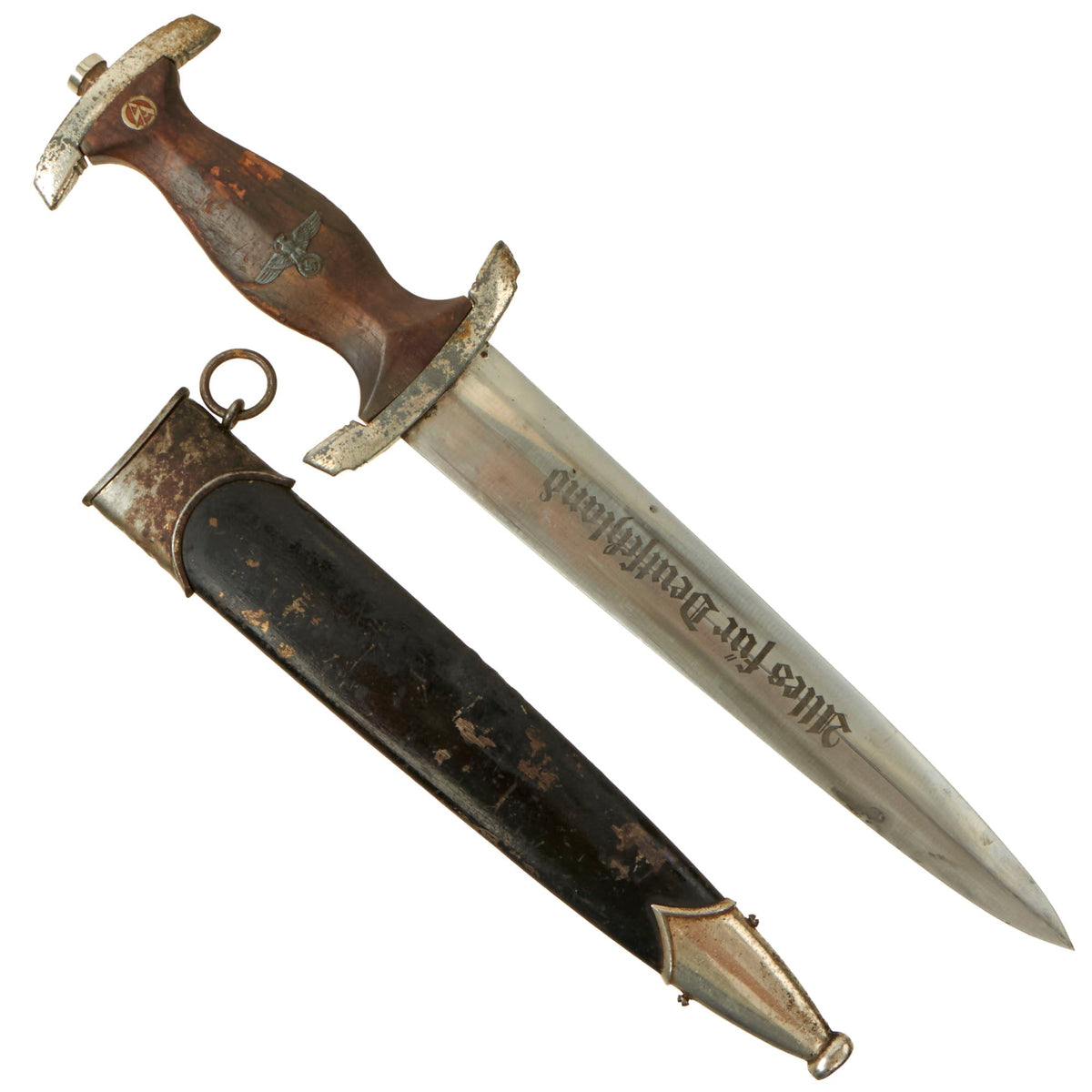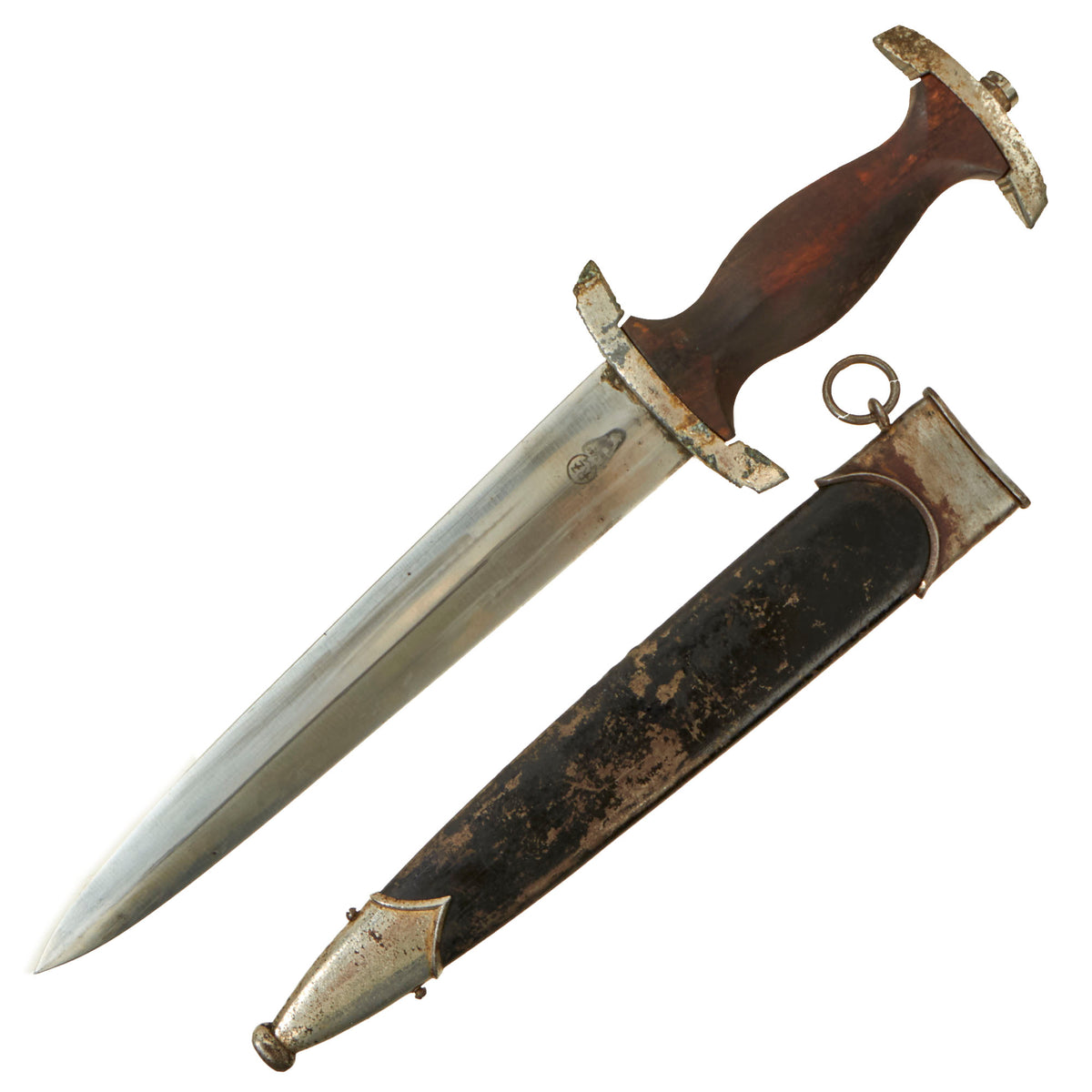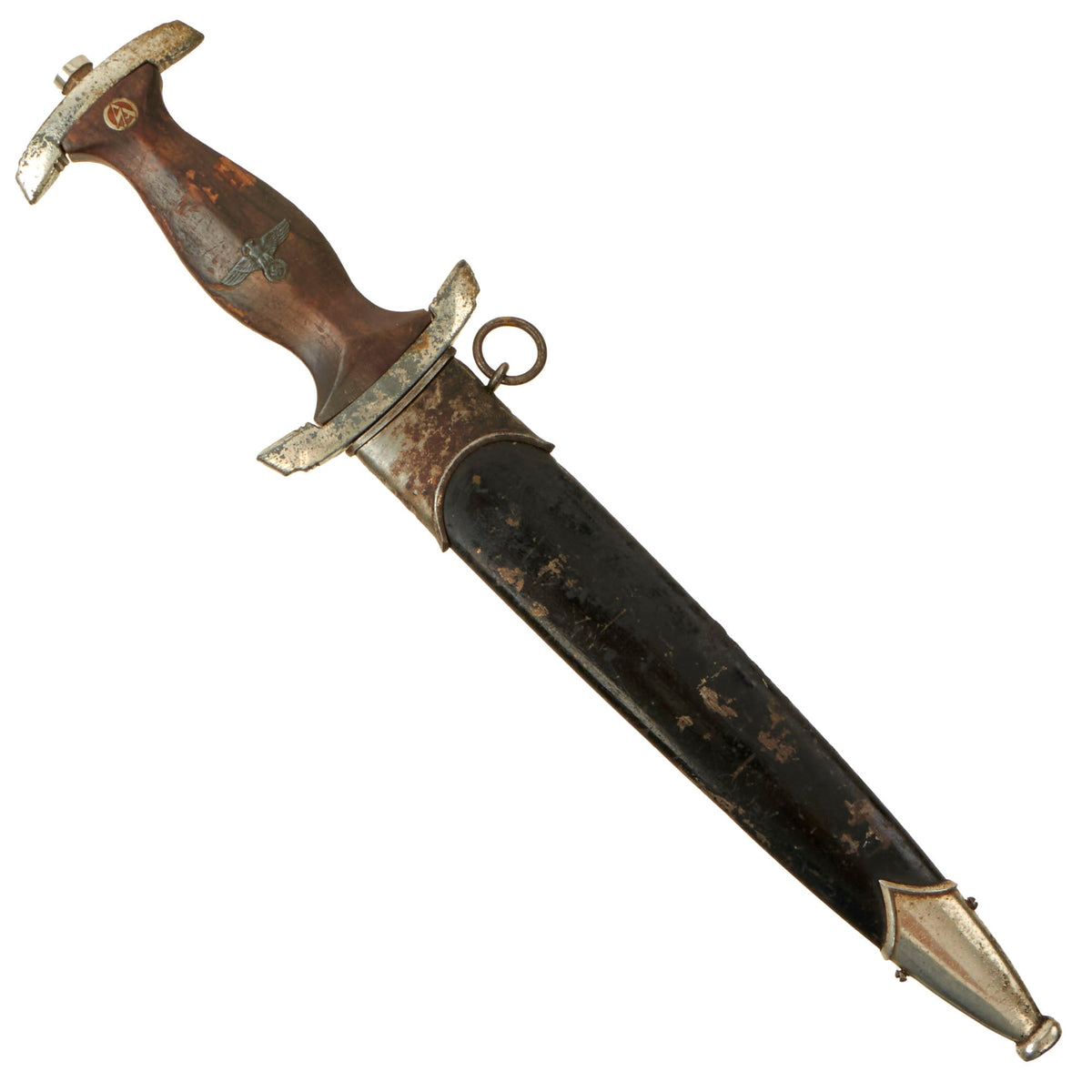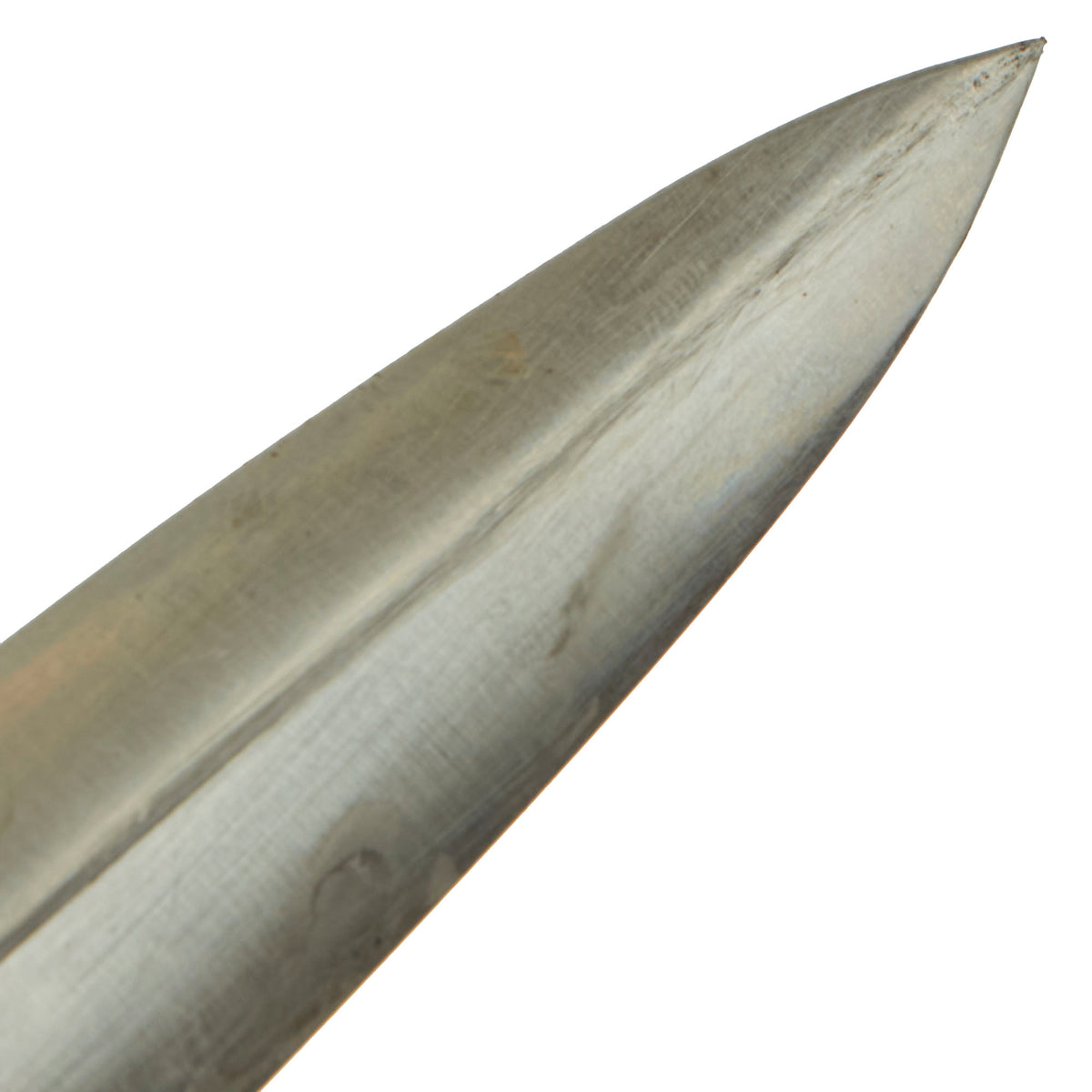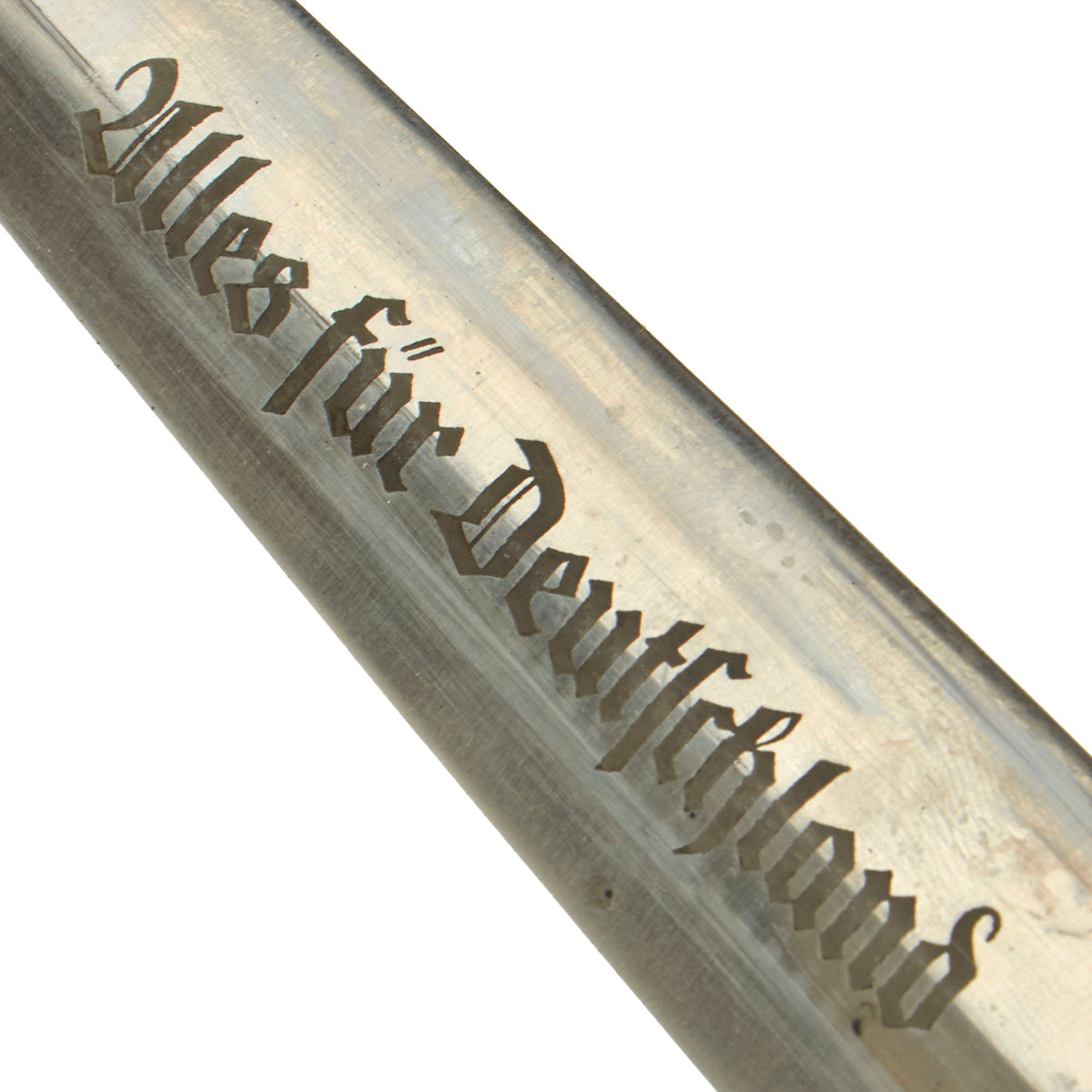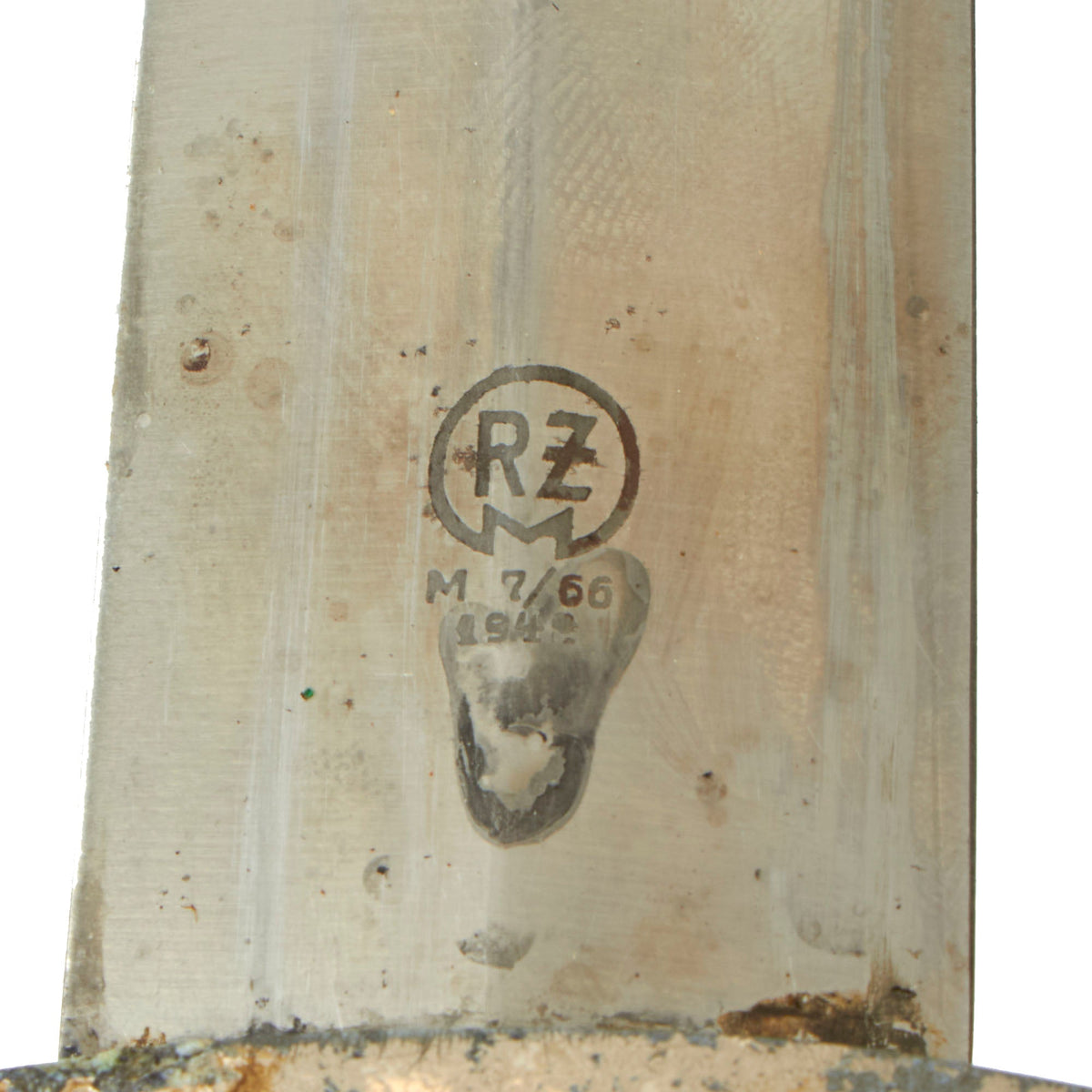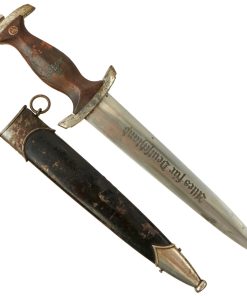Original German WWII 1941 Dated NSKK Dagger by Carl Eickhorn with Excellent Blade & Scabbard – RZM M7/66 Original Items
$ 750,00 $ 225,00
Original Item: Only One Available. This very good condition mid-late war period produced NSKK Dagger has nickel-plated fittings throughout, and is fitted with an exceptionally good blade, which definitely contrasts to the worn and oxidized fittings. It looks like it was exposed to the elements, but never really unsheathed, so the scabbard was able to do its job, protecting the blade, while the fittings oxidized. This example was made by the the legendary Solingen-based firm of Carl Eickhorn, Stahlwarenfabrik.
These daggers are identical to the SA dagger, except they have a black finished scabbard. The guards and tang nut are nickel plated alloy, probably zinc or some other “pot metal”, and have lost a lot of the plating, which has probably flaked away, allowing the fittings to oxidize. There is no cracking through the alloy, but they definitely show quite a bit of patination, which we have left intact to preserve the patina. The nickel plated steel end nut shows light oxidation, with no real signs of being turned.
The grip has the correct medium center ridge construction, however it also has definitely suffered the effects of weathering, now showing a worn look, with traces of the original red mahogany tone present on the back. It shows some wear and chipping, but no major cracking, and has shrunk a bit over the years. The SA / NSKK button itself is still nicely set having fully intact translucent enameling, and the plating partly with some verdigris and oxidation as shown. The details are still there to the inlaid alloy eagle, including the beak, breast feathering, wing feathering, talons, wreath and mobile swas, however it has turned a dark blue color.
In contrast to the fittings, the blade of this example is in very good near excellent condition and has virtually all of its factory final polish grind crossgrain present. This texture is iconic, and is the definitive identifying characteristic for a real WWII German Blade. There are a few small areas of water staining with some oxidation, but aside from that it looks great, and the original factory edge is still intact. There is also the usual runner wear from the scabbard. The acid-etched Alles für Deutschland (Everything for Germany) SA motto is deep and crisp, with a fine frosted background typical of WKC that is retained at nearly 100%. This is really a great blade that would be very hard to improve upon!
The rear is etched with the RZM contract information, which is fully visible.
(RZM)
M7 / 66
1942
This marking indicates the dagger was made by RZM Dagger contractor “66”, which records show is the legendary maker Carl Eickhorn, Stahlwarenfabrik (steel ware factory), located in Solingen, the “City of Blades” in western Germany.
According to J. Anthony Carter’s book, GERMAN KNIFE AND SWORD MAKERS, this company was founded in 1865 by Carl Eickhorn, and is arguably the most famous of all Solingen makers. Not only could the family trace their history back 500 years, but they could also demonstrate involvement in the hardening and grinding industries for the same period. Truly the nobility of Solingen Edged weapon dynasties. Eickhorn edged weapons are the most desirable of all makers.
The Reichszeugmeisterei (National Quartermaster’s Office), or RZM, was was based at the Brown house in Munich and NSDAP party headquarters in Berlin. The RZM ensured that the manufacturers of military items were consistent in design, quality of materials and other characteristics of the items. It also defined standards of design, manufacturing and quality and published an authoritative color chart for textiles. The M7 in the code stands for knives/daggers, contractor 66 stands for Carl Eickhorn of Solingen.
The scabbard shell is straight throughout and is the mid-war style, which has a black enamel lacquered steel body. The enamel looks to possibly have been re-applied during the war, as it shows brush strokes, however it was definitely repainted during the WWII period. It has degraded due to age and weathering, showing a lovely patina. It has flaked away in some areas, allowing the steel body to oxidize. The upper and lower fittings are nickel-plated steel, and show plating loss and oxidation from use. The lower ball of the chape fitting is crushed in, common even on the harder steel alloy, and the dome-head screws on the locket are missing.
A lovely service used NSKK dagger from the most legendary of all Solingen makers, with a fantastic blade and original scabbard. Ready to display!
Specifications:
Blade Length: 8 3/4″
Overall length: 13 3/4”
Crossguard: 3”
Scabbard Length: 10”
History of the SA and NSKK-
The SA or Brown Shirts, were a private political formation which Adolf AH and the NSDAP used to maintain order at organized Party meetings and demonstrations. The group was formed in 1921, and grew to a huge force of nearly 3,000,000 men by the later 1930’s. To instill esprit de corps, as well as create employment for the Blade City of Solingen, it was decided each SA man would carry a dagger with his Brown Shirt uniform. Huge quantities needed to be produced to accommodate the demand. The dagger initially was produced of hand-fitted nickel mounts with attractive finished wood grip and brown anodized (a bluing process) finished scabbard.
The blade was etched with the SA motto, Alles für Deutschland. Examples produced prior to 1935 were stamped with the German sector of the SA group on reverse lower crossguard. Later examples underwent standardization through the RZM ministry. These pieces were produced of cheaper plated zinc-base fittings and scabbards were simply painted brown.
Prior to his “unmasking” as a traitor, Ernst Röhm was the leader of the SA. In 1934, he distributed approximately 100,000 SA daggers with his personal inscription on the reverse blade. These daggers were to honor individuals who had served with the SA prior to December, 1931. Other than the inscription, these pieces were identical to the standard M1933 SA dagger. After the Röhm purge, the inscription was ordered to be removed. Many examples were returned to the factory for grinding. Others were simply ground in the field by whatever means were available. Examples will occasionally be encountered with remnants of the original inscription remaining on the blade, but mostly none will remain. Some blades exist with an intact inscription, reflecting only the removal of the Röhm signature. Very very rarely is an example seen with a full, untouched inscription, as the holder would have surely risked a charge of treason.
After the purge, the NSKK, which had been a part of the SA, was split off into a separate organization. They retained the same daggers as the SA, however now used a black painted scabbard, and their officer’s daggers had a few differences as well. Many already had SA daggers, so these had the scabbards painted black over the original brown anodized finish.
Fast Shipping with Professional Packaging
Thanks to our longstanding association with UPS FedEx DHL, and other major international carriers, we are able to provide a range of shipping options. Our warehouse staff is expertly trained and will wrap your products according to our exact and precise specifications. Prior to shipping, your goods will be thoroughly examined and securely secured. We ship to thousands clients each day across multiple countries. This shows how we're dedicated to be the largest retailer on the internet. Warehouses and distribution centres can be located throughout Europe as well as the USA.
Note: Orders with more than one item will be assigned a processing date depending on the item.
Before shipping before shipping, we'll conduct a thorough inspection of the items you have ordered. Today, the majority of orders will be delivered within 48 hours. The delivery time will be between 3-7 days.
Returns
The stock is dynamic and we cannot completely manage it because multiple stakeholders are involved, including our factory and warehouse. So the actual stock may alter at any time. It's possible that you may not receive your order once the order has been made.
Our policy is valid for a period of 30 days. If you don't receive the product within 30 days, we are not able to issue a refund or an exchange.
You can only return an item if it is unused and in the same state as the day you received it. You must have the item in its original packaging.
Related products
Uncategorized
Uncategorized
Uncategorized
Uncategorized
Uncategorized
Uncategorized
Uncategorized
Band of Brothers ORIGINAL GERMAN WWII Le. F.H. 18 10.5cm ARTILLERY PIECE Original Items
Uncategorized
Uncategorized
Uncategorized
Uncategorized
Uncategorized
Uncategorized
Uncategorized
Uncategorized
Uncategorized
Uncategorized
Uncategorized
Uncategorized
Uncategorized
